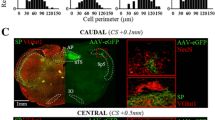Summary
Electrical activation of the ipsilateral arcuate region of the hypothalamus produced an inhibitory influence upon three separate subpopulations of cells encountered in the ventrolateral PAG. Quiescent PAG cells were classified by their response pattern to sural nerve stimulation: Type A cells displayed only a short latency discharge; whereas, Type B cells exhibited a triphasic response pattern. Arcuate nucleus stimulation dramatically reduced the evoked discharge of both A and B cell types. Type C cells represented spontaneously active PAG neurons which were less affected by arcuate nucleus activation. Systemic naloxone (5 mg/kg) reduced the degree of inhibition of only Type B neurons. Naloxone was ineffective in attenuating arcuate inhibition of Type A and C neurons. Type B neurons may represent a class of cells which are more involved in nociceptive systems and therefore are susceptible to modulation by endogenous opiate peptides.
Similar content being viewed by others
References
Bloom FE, Rossier J, Battenberg LF, Bayon A, French E, Henriksen SJ, Siggins GR, Segal D, Browne R, Ling R, Guillemin R (1978) β-Endorphin: Cellular localization, electrophysiological and behavioral effects. In: Costa E, Trabucchi M (eds) Advances in biochemical psychopharmacology, vol 18. Raven Press, New York, pp 89–109
Bloom F, Segal D, Ling N, Guillemin R (1976) Endorphins, profound behavioral effects in rats suggest new etiological factors in mental illness. Science 194: 630–632
Duka TH, Schubert P, Wuster M, Stoiber R, Herz A (1981) A selective distribution pattern of different opiate receptors in certain areas of rat brain as revealed by INVITRO autoradiography. Neurosci Lett 21: 119–124
Frederickson RCA, Norris FH (1976) Induced depression of single neurons in brain areas with opiate receptors, antagonism by naloxone. Science 194: 440–442
Fung SJ, Barnes CD (1977) Antinociceptive effect of dopaminergic neurotransmission evoked by mesencephalic stimulation on spinal interneuronal activity in cats. In: Messiha FS, Kenny AD (eds) Advances in experimental medicine and biology, vol 90. Plenum Press, New York, pp 233–242
Gasser HS (1943) Pain-producing impulses in peripheral nerves. Res Publ Assoc Nerv Ment Dis 23: 44–59
Goldstein FJ, Malseed RT (1978) Detection of narcotic analgesic activity utilizing a cat tail flick procedure. Pharmacologist 20: 242
Herz A, Albus K, Metys J, Schubert P, Teschemacher H (1970) On the central sites for the antinociceptive action of morphine and fentanyl. Neuropharmacology 9: 539–551
Johansson O, Hokfelt T, Elde RP, Schultzberg M, Terenius L (1978) Immunohistochemical distribution of enkephalin neurons. In: Costa E, Trabucchi M (eds) Advances in biochemical psychopharmacology, vol 18. Raven Press, New York, pp 51–70
Kuhar MJ, Pert CB, Snyder SH (1973) Regional distribution of opiate receptor binding in monkey and human brain. Nature 245: 447–450
Kuhar MJ, Uhl GR (1979) Histochemical localization of opiate receptors and the enkephalin neurochemical mechanisms of opiates and endorphins. In: Loh HH, Ross DH (eds) Advances in biochemical psychopharmacology, vol 20. Raven Press, New York, pp 53–55
Lewis VA, Gebhart GF (1977) Evaluation of the periaqueductal central gray (PAG) as a morphine specific locus of action and examination of morphine-induced and stimulation-produced analgesia at coincident PAG loci. Brain Res 124: 283–303
Loh HH, Li CH (1977) Biologic activities of β-endorphin and its related peptides. Ann NY Acad Sci 297: 115–130
Nicoll RA, Siggins GR, Ling N, Bloom FE, Guillemin R (1977) Neuronal actions of endorphins and enkephalins among brain regions: A comparative microiontophoretic study. Proc Natl Acad Sci USA 74: 2584–2588
Pert CB, Snyder SH (1973) Opiate receptor: Demonstration in nervous tissue. Science 179: 1011
Pert A, Yaksh T (1974) Sites of morphine induced analgesia in the primate brain; relation to pain pathways. Brain Res 80: 135–140
Simantov R, Kuhar MJ, Pasternak GW, Snyder SH (1976) The regional distribution of a morphine like factor enkephalin in monkey brain. Brain Res 106: 189–197
Simantov R, Kuhar MJ, Uhl GR, Snyder SH (1977) Opiod peptide enkephalin, immunohistochemical mapping in the rat central nervous system. Proc Natl Acad Sci USA 74: 2167–2171
Strahlendorf HK, Strahlendorf JC, Barnes CD (1980) Endorphin mediated inhibition of locus coeruleus neurons. Brain Res 191: 284–288
Terenius L (1973) Stereospecific interaction between narcotic analgesics and a synaptic plasma membrane fraction of rat cerebral cortex. Acta Pharmacol Toxicol 32: 317
Tsou K, Jang CS (1964) Studies on the site of analgesic action of morphine by intracerebral microinjection. Sci Sin 13: 1099–1109
Author information
Authors and Affiliations
Additional information
Supported in part by grants from the Tarbox Parkinson's Disease Institute and NIH Grant HL 7289
Rights and permissions
About this article
Cite this article
Strahlendorf, J.C., Strahlendorf, H.K. & Barnes, C.D. Inhibition of periaqueductal gray neurons by the arcuate nucleus: Partial mediation by an endorphin pathway. Exp Brain Res 46, 462–466 (1982). https://doi.org/10.1007/BF00238642
Received:
Accepted:
Published:
Issue Date:
DOI: https://doi.org/10.1007/BF00238642



